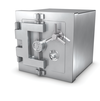Hide information in images using Steg
|
Data Acquisition
After adjusting all the options, the next step is to embed the message in the carrier file. To do this, either click the seventh button from the left in the button bar or select the Hide Data… option from the Hide menu. Then, determine the content to be embedded in the next dialog in the file manager. Steg immediately merges the two files and displays a corresponding message upon completion.
The software also accepts archives as files to be embedded. Compressing beforehand doesn't just save space, it also makes it possible to hide more source files in a single data carrier.
Steg will issue a corresponding message if the size of the data file exceeds the maximum storage volume of the data carrier. It's a good idea to split the data and to embed it in multiple carrier files or to use a data carrier that provides a larger storage volume.
Finally, you need to save the container file you've just created. To do this, click the disk icon in the button bar and enter the storage path and file name in the file manager. Steg support the TIFF, PNG (uncompressed), and JPG (compressed) formats for the containers.
Extracting
It's pretty easy to extract content from a steganographically modified container file. First, load the container file in the program. If you've also encrypted the file symmetrically or asymmetrically, call up the Configuration menu and enter the authentication data here.
Second, click the Extract entry in the menu line of the program window, followed by Extract Data…. . Then, enter the target path to which Steg should extract the content in the file manager that opens separately. In the final step, the application extracts the data in the target directory and, in doing so, might manually store additional entered text in a separate file.
« Previous 1 2 3 4 Next »
Buy this article as PDF
Pages: 4
(incl. VAT)






